Entering the "new normal" and growing steadily
A new report from PricewaterhouseCoopers (PwC) shows that rising medical costs have entered a “new normal†with a milder year-on-year growth.
The report says that the era of rising medical costs and growing at double-digit rates seems to be coming to an end.
PricewaterhouseCoopers expects that there will be a steady trend starting next year, and there will be more moderate growth in the next few years with single-digit growth.
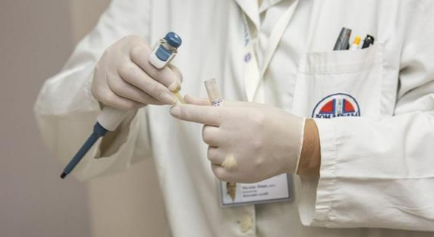
In the past four years, the trend of medical costs in the United States has been between 6% and 7%, and it seems to have entered the "new normal." (The medical cost trend is the expected percentage increase in the patient's annual treatment cost. For example, a 10% trend means that today's $10,000 treatment cost will cost $11,000 next year.)
PwC's Health Research Institute (HRI) expects its annual growth rate to be 6.5% in 2018, 0.5 percentage points higher than in 2017.
In this study, HRI interviewed US industry executives, health policy experts, and health plan actuaries. HRI also analyzed the results of the PwC 2017 Health and Wellbeing Index survey, surveyed more than 780 employers from 37 industries, and an HRI national consumer survey of 1,500 US adults.
The forecast is based on HRI's analysis of the health care costs of the employer's insurance market, which covers more than 150 million active employees.
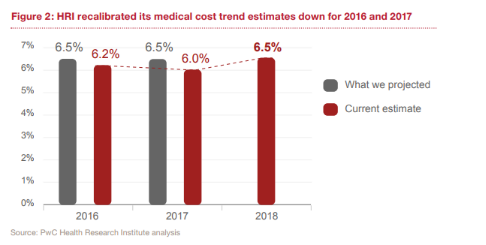
Figure 1: This report adjusts the previous forecasted medical cost trends
In the past three decades, the growth of corporate medical spending has been gradually slowing down. This slowdown is not current, but fluctuating up and down. Recently, the trend has been reduced from double digits to single digits, indicating that trend changes will be more moderate.
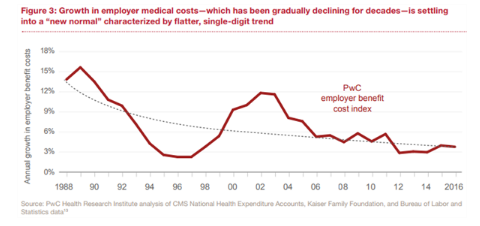
Figure 2: Changes in medical cost trends in the past 30 years
This report found that in 2018, many factors will cause fluctuations in the trend of medical costs, including inflation rate, medical insurance quota, drug patents, public opinion supervision, and economic factors.
Higher costs are not sustainable
Although the growth rate of medical costs is between 6% and 7%, the growth rate of medical expenditures still exceeds the economic growth rate.
From 2011 to 2016, the average health premium for home insurance purchased through the company increased by 20%. In the same period, wages only increased by 11%. This gap reduces the disposable income of consumers and limits the spending power of governments and individuals.
In the United States, health care costs are expected to continue to grow faster than gross domestic product (GDP), and health care will continue to occupy a larger share of the economy.
This could lead to larger budget deficits or a reduction in spending in areas such as education, infrastructure and defense.
Even the more stable “new normal†is unsustainable.
This report expects medical cost growth in 2018 to be 6.5% (see Figure 3). After considering the high premiums paid by companies and the suppliers that do not have much choice, the net growth rate is expected to reach 5.5% in 2018.
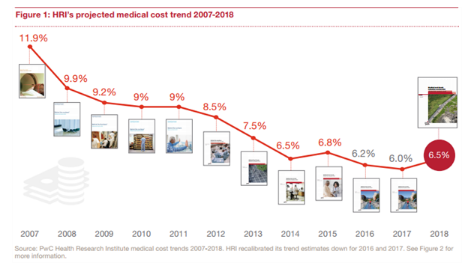
Figure 3: Trends in medical costs
Companies often pass costs on to employees
Over the years, companies have largely reduced their costs by passing costs on to employees, and these employees have reduced their use of medical products and services.
Many people expressed dissatisfaction with the high deductible health insurance plan. They have also given up on optional services such as preventive care, although this can save costs in the short term, but it can lead to costly long-term treatment costs.
As a result, WHO and healthcare companies will have to reconsider their service prices and utilization rates. In 2018, companies should consider signing new contracts with suppliers to negotiate the right price, rather than passing the cost on to employees.
This trend may be weakened in the future. According to the 2017 PricewaterhouseCoopers Health and Wellbeing Index survey, only 28% of employers consider providing high deductible health insurance for employees in the next three years, down from 44% in 2014. Peak.
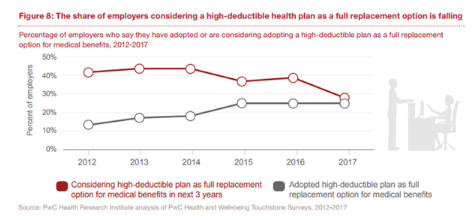
Figure 4: The proportion of companies offering only high deductible health insurance plans has decreased
They have realized that giving up or delaying treatment by employees will lead to long-term productivity reductions and increased costs of long-term care.
A 2017 HRI consumer survey shows that individuals registered in the high deductible plan have the possibility of delaying or canceling surgery or taking drugs in the previous year than those with lower deductible health insurance. It is nearly 60% higher.
Medical service providers, health insurance companies, and pharmaceutical companies can all work hard to increase transparency across the industry, deepen cooperation, and set more reasonable prices.
If there is no low utilization of medical services as a balance, rising costs may increase overall medical costs (see Figure 5).
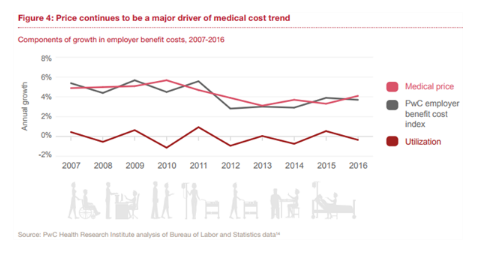
Figure 5: Price is the main driver of healthcare cost trends
But not all costs share the same share of total cost (see Figure 6). In 2018, hospitalization costs may account for half of all medical expenses.
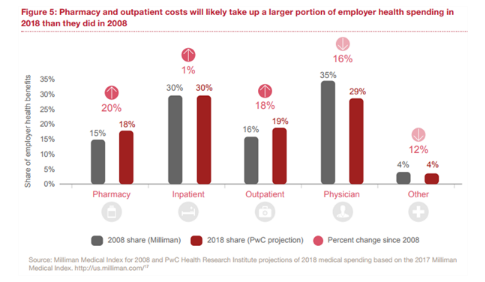
Figure 6: Proportion of parts in the cost of medical treatment
Currently, about 30% of the expenses are hospitalization expenses, about 19% are outpatient expenses, 29% are medical expenses, and 18% are prescription drugs.
Over the past decade, spending on prescription drugs and hospital outpatient clinics has been increasing, while hospitalization costs have remained stable and medical costs have continued to decrease.
For example, between 2008 and 2018, the proportion of drug expenditure increased from 15% to 18%, while the proportion of medical services in the same period fell from 35% to 29%.
These changes are due to the faster growth of some parts and the lower growth rate of others.
Inflation leads to rising medical costs
Since 2011, the growth of the Consumer Price Index (CPI) has been slowing.
Fluctuations in inflation rates are difficult to measure in real time, and their impact on the healthcare market is often lagging behind.
Therefore, the impact of rising inflation rates in 2016 and 2017 will not appear until 2018.
From 2015 to 2016, the CPI growth rate increased by 1.2 percentage points. In March 2017, the Federal Reserve (Fed) raised interest rates for the second time in three months. This is the third rate hike since 2009, which indicates that the economy will continue to expand.
As wages rise, gross domestic product (GDP) rises, and the unemployment rate fell to 4.4% in April 2017 – economists believe it is close to the 10-year low of “full employmentâ€.
It is expected that CPI will grow again in 2017 and 2018, when it will reach 2.6%, which is the highest level since 2012 (see Figure 7). In 2015, this figure was 0.1%.
Inflation affects all prices in the economy, and health care costs are no exception. This is the third long period of expansion in American history. The growth of the US economy and higher total inflation rate will affect labor-intensive health sectors, pushing up wage levels and medical prices.
Inflation also affects the costs of inputs such as energy costs, medical equipment and pharmaceuticals. As suppliers pass on costs through price increases, the overall price of the industry has risen.
As the US economy heats up, overall inflation may put more upward pressure on wages, medical prices, and overall cost trends in 2018.
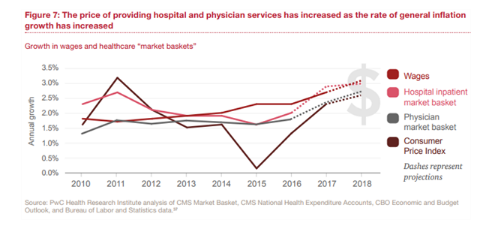
Figure 7: Increase in inflation rate leads to an increase in the price of medical services
Expiration of patents leads to an increase in medical expenses
Fewer brand drug patents expire, which reduces the number of low-cost generics and increases drug prices faster.
Drug patents due in 2016 accounted for $18.9 billion in US pharmaceutical sales, 32% less than in 2015 (see Figure 8). In 2017, drug patents worth $11.1 billion fell by 41.3% from 2016.
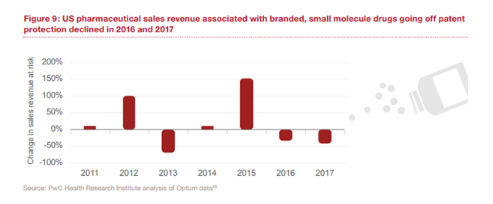
Figure 8: US drug sales in recent years
In general, the price of generic drugs is usually 80% to 85% lower than the original price of the brand in the years after the patent expires, which can save a lot of money.
Low-cost generics usually appear within a year or two after the patent expires (see Figure 9). This is because generic manufacturers can sometimes monopolize the market in a short period of time.
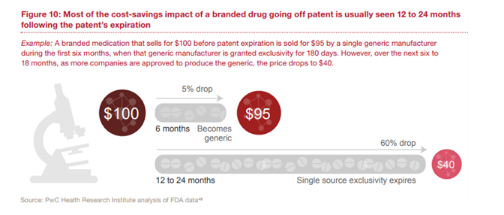
Figure 9: Price changes for low-cost generics
The impact of biosimilars on medical costs is similar. However, by May 2017, only five biosimilars were approved, and the US biosimilar market is still evolving, and biosimilars are expected to save only 25%.
Public opinion puts pressure on drug prices
In the past few years, the doubling of the price of certain drugs has been common in newspapers.
According to a HRI survey, in 2017, 69% of consumers believe that a pharmaceutical company – even if it can prove that the price is reasonable – should not charge the drug indiscriminately. Two years ago, only 52% of consumers shared the same feeling.
Consumers also told HRI that the government should tighten regulation of drug prices when considering ways to reduce medical costs.
Prior to the 1991 special elections, the consumer price index for prescription drugs increased by nearly 10%. By 1995, after the Clinton administration’s medical reform efforts failed, the prescription drug consumer price index (CPI) increased by 2%.
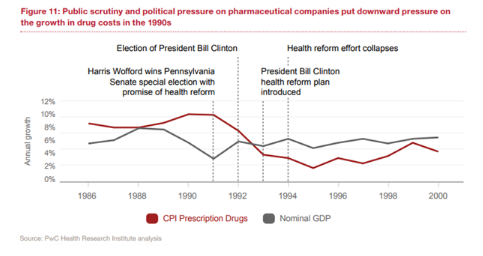
Figure 10: Public opinion and political factors also have an impact on drug prices
New technology reduces medical costs
New technologies such as artificial intelligence can give better answers to human treatment options.
As the price of genetic testing declines, there is growing interest in personalized drug delivery.
In addition, people often take a step-by-step approach—try cheaper drugs first, and if they don't, buy more expensive ones. Reducing the amount of dosing at the time of prescription also reduces waste.
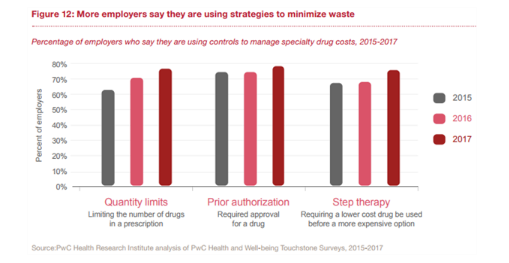
Figure 11: Some companies are adopting new treatment strategies to avoid waste
Some treatments such as self-injection at home will also cost less than going to the hospital.
Emerging Internet services such as smartphone apps have not been widely promoted in the medical industry . “Palming†medical services will help reduce costs, provide new access to medical care, and meet the needs of consumers “anytime, anywhere†for monitoring, diagnosis, and treatment.
Primary care and chronic disease management can also take advantage of new technologies. New concept medical devices such as health tracking, symptom monitoring, blood glucose self-tests, mobile electrocardiograms and other devices monitor their physical condition or send relevant data to the doctor.
Fast web services also offer more possibilities for remote video clinics.
In addition, the field of mental health can also be used for remote medical treatment through the Internet. In 2014, the US Department of Veterans Affairs used video conferencing to conduct 325,000 mental health teleconsultations for more than 100,000 veterans in local community clinics. Thanks to the development of these services, the hospitalization rate for mental illness has been reduced by 24%. Now, the department is applying the same technology to veterans' homes, enabling them to directly access screening and education services through computers, tablet devices and Internet apps.
Internet medical startups are naturally not far behind. For example, Lyra Health and Doctor on Demand are driving changes in the personal space that allow consumers to connect to clinical psychologists simply by simply operating on their smartphones. At the same time, technologies for diagnosing mental illness through biometric markers, such as the virtual prosecutor "Ai Li" developed by the University of Southern California, are gradually becoming a reality.
Other influencing factors
Income is also one of the factors that influence the trend of medical costs. In general, the higher the income, the higher the medical expenses.
Despite the slow economic growth over the past decade, average income has increased, leading to an increase in medical spending.
Population is another factor. In recent years, the labor force has been aging. In 2012, 15.9% of the labor force was between 55 and 64 years old. By 2022, this proportion is expected to increase to 17.3%, and the elderly workforce usually has more health needs, which leads to an increase in medical expenses.
According to HRI analysis, from 2012 to 2022, aging will account for 0.4% of the company's annual medical expenditure growth.
Lifestyles such as obesity, smoking, drug abuse, malnutrition and lack of physical activity can increase health care spending. More than 70% of Americans are considered overweight, and the abuse of opioids such as heroin and prescription painkillers is also increasing.
These growing health risks have raised medical costs. Paying more attention to these risks and improving existing health plans may help curb rising medical costs.
The last thing worth mentioning is industry consolidation. In recent years, the number of M&A activities by suppliers, pharmaceutical companies and life science companies has surged. As companies begin to unite and gain greater market share, they will have more say in pricing, so they can build a unified health care market that could lead to price increases.
Technological innovation is another factor. The pharmaceutical, life sciences, and medical device industries are investing in research and development to launch new products every year, some of which are expensive and may improve treatment.
For example, a more sensitive diagnostic test may make it easier to spot potential health problems and avoid subsequent unnecessary treatment.
Cost-saving innovations will also put downward pressure on medical spending. Due to advances in technology, the cost of care for inpatients has been declining as more and more operations can be performed in the clinic.
New technologies for remote consultation and surgery also make traditional medical services more convenient and effective.
Government regulation, such as policies to expand the practice of nurses, has been shown to reduce primary care costs.
While the shift in payment models is still small, early findings suggest that they can help curb the growth of health spending by increasing cost transparency, quality of care, and medical service bookings.
Today's businesses also often encourage patients to take alternative therapies, such as following a healthier lifestyle to treat chronic diseases rather than taking expensive drugs for long periods of time.
Some incentive programs propose linking incentives such as gift cards and shopping discounts to health indicators such as blood pressure or weight.
Conclusion
Medical expenses are closely related to our lives and are far more complicated than most people think. Referring to the structural components and influencing factors of medical expenses in other countries can bring us a lot of thinking.
Wide Angle Ptz Camera,Wireless Camera Ip,Waterproof Wireless Cctv Camera,Outdoor Wifi Camera
Shenzhen Zuomi Technology Co., Ltd. , https://www.zuomicamera.com